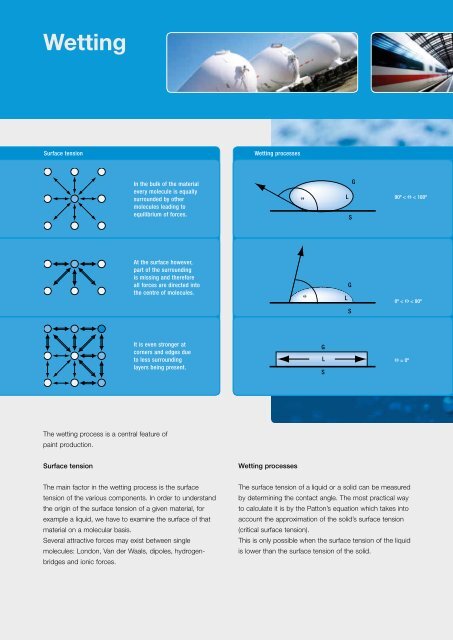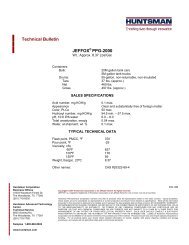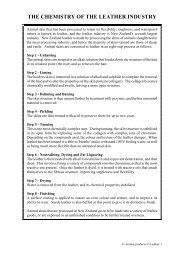BASF defoaming explanaiton
Create successful ePaper yourself
Turn your PDF publications into a flip-book with our unique Google optimized e-Paper software.
Wetting<br />
Surface tension<br />
Wetting processes<br />
In the bulk of the material<br />
every molecule is equally<br />
surrounded by other<br />
molecules leading to<br />
equilibrium of forces.<br />
<br />
L<br />
S<br />
G<br />
90º < < 180º<br />
At the surface however,<br />
part of the surrounding<br />
is missing and therefore<br />
all forces are directed into<br />
the centre of molecules.<br />
<br />
L<br />
G<br />
0º < < 90º<br />
S<br />
It is even stronger at<br />
corners and edges due<br />
to less surrounding<br />
layers being present.<br />
G<br />
L<br />
S<br />
= 0º<br />
The wetting process is a central feature of<br />
paint production.<br />
Surface tension<br />
Wetting processes<br />
The main factor in the wetting process is the surface<br />
tension of the various components. In order to understand<br />
the origin of the surface tension of a given material, for<br />
example a liquid, we have to examine the surface of that<br />
material on a molecular basis.<br />
Several attractive forces may exist between single<br />
molecules: London, Van der Waals, dipoles, hydrogenbridges<br />
and ionic forces.<br />
The surface tension of a liquid or a solid can be measured<br />
by determining the contact angle. The most practical way<br />
to calculate it is by the Patton’s equation which takes into<br />
account the approximation of the solid’s surface tension<br />
(critical surface tension).<br />
This is only possible when the surface tension of the liquid<br />
is lower than the surface tension of the solid.











![[Ulwick_A.W.]_Business_Strategy_Formulation_Theor(BookZZ.org)](https://img.yumpu.com/56355932/1/190x240/ulwick-aw-business-strategy-formulation-theorbookzzorg.jpg?quality=85)



![Desmond Morris - 2002 - Peoplewatching - The Desmond Morris Guide to Body Language (poor quality-double page)(290p) [Inua]](https://img.yumpu.com/54998318/1/189x260/desmond-morris-2002-peoplewatching-the-desmond-morris-guide-to-body-language-poor-quality-double-page290p-inua.jpg?quality=85)
